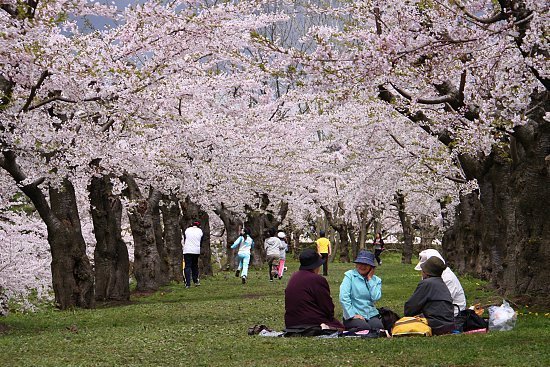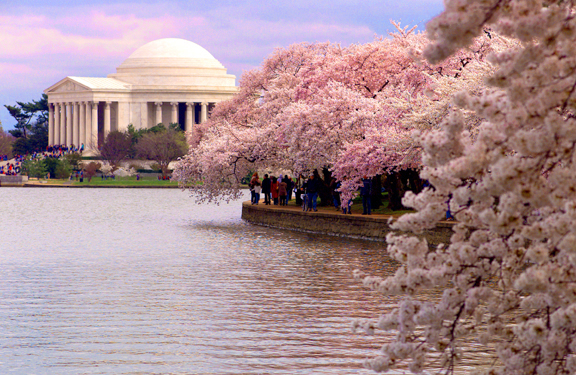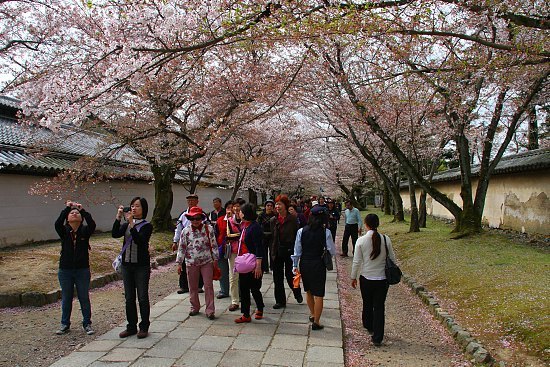
[Article] Hanami Festival or Cherry Blossoms Festival in Japan
เทศกาลฮานามิ หรือ เทศกาล “ดอกซากุระบาน”
Roytavan : Writer & Translator
Original : http://twssg.blogspot.com/
Source : http://www.japan-guide.com/ , http://www.wikipedia.com/

ซากุระ (桜/ 櫻) ดอกไม้ประจำชาติของญี่ปุ่น
ซากุระ (ภาษาญี่ปุ่น : 桜 หรือ 櫻) เป็นดอกไม้ประจำชาติของประเทศญี่ปุ่น มีถิ่นกำเนิดในจีนตอนใต้ เกาะไต้หวัน หมู่เกาะโอกินาวา ญี่ปุ่น ลักษณะเด่นของซากุระก็คือ เมื่อร่วง จะร่วงพร้อมกันหมด ซากุระจึงเป็นสัญลักษณ์ของเลือดทหารและซามูไรของญี่ปุ่น
มีดอกซากุระในเกาหลี, สหรัฐอเมริกา, แคนาดา, จีน หรือที่อื่นๆ แต่ไม่มีกลิ่น ขณะที่ซากุระของญี่ปุ่นนั้นผู้คนจำนวนมากยกย่องชื่นชมกลิ่นของมัน และมักจะกล่าวฝากไว้ในบทกวี
ดอกซากุระของญี่ปุ่นนี้ ในภาษาอังกฤษมีคำเรียกทั่วไปว่า “cherry blooms” หรือ “cherry blossom” หรือไม่ก็ “Japanese Flowering Cherry” จะบานในช่วงปลายมีนา-ต้นเดือนเมษายน ซึ่งเป็นช่วงเริ่มต้นฤดูใบไม้ผลิ อุณหภูมิเริ่มอุ่นขึ้นจากฤดูหนาวที่หมดไป
ดอกซากุระ ในภาษาญี่ปุ่นนั้น เชื่อกันว่ากร่อนมาจากคำว่า ซะกุยะ (หมายถึง ผลิบาน) อันเป็นชื่อของเจ้าหญิง โคโนฮะนะซะคุยาฮิเม มีศาลบูชาของพระองค์อยู่บนยอดเขาฟูจิด้วย สำหรับพระนามของเจ้าหญิงองค์ดังกล่าวนั้น มีความหมายว่าเจ้าหญิงดอกไม้บาน และเนื่องจากซากุระเป็นดอกไม้ที่นิยมกันมากในญี่ปุ่นสมัยนั้น คำว่าดอกไม้ดังกล่าวจึงหมายถึงดอกซากุระนั่นเอง เจ้าหญิงองค์ดังกล่าวได้รับพระนามเช่นนั้น ก็เพราะมีเรื่องเล่ามาว่าทรงตกจากสวรรค์ มาบนต้นซากุระ ดังนั้น ดอกซากุระจึงถือเป็นตัวแทนของดอกไม้ญี่ปุ่น ขณะที่รัฐบาลประกาศให้ดอกเก็กฮวย (ดอกเบญจมาส) เป็นดอกไม้ประจำชาติ

บทเพลงและปรัชญาที่เกี่ยวกับดอกซากุระ :
ดอกซากุระนอกจากจะเป็นดอกไม้ประจำชาติแล้ว ยังถือเป็นเจ้าแห่งดอกไม้ของญี่ปุ่นอีกด้วย ดอกซากุระจึงถือเป็นสิ่งมงคล เป็นดอกไม้แห่งการเริ่มต้น เพราะดอกซากุระจะเริ่มบานในช่วงฤดูใบไม้ผลิที่เปรียบเป็นฤดูแห่งการเริ่มต้นหลายๆ อย่าง นับว่าเป็นช่วงเวลาแห่งความสดชื่น สดใส ดอกซากุระจะอยู่ให้ชืนชมความงามหลังจากบานเต็มที่ประมาณ 7 วันก็จะเริ่มร่วงโรย และช่วงเวลาที่ซากุระร่วงนั้นก็ดูสวยงามไม่แพ้กัน หากแต่เป็นความงดงามอีกแบบหนึ่ง จนมีสำนวนในภาษาญี่ปุ่นกล่าวถึง "ซากุระ 7 วััน" ซึ่งหมายถึงว่า "ความงามนั้นล้วนไม่จีรังยั่งยืน" ซึ่งใช้เป็นข้อเตือนใจได้เป็นอย่างดีของชาวญี่ปุ่น นอกจากนี้ยังมีความหมายที่แฝงเป็นสัจธรรมในการให้กำลังใจอยู่ด้วย ซึ่งหมายถึง "ทุกสรรพสิ่งล้วนมีการเริ่มต้นได้ใหม่เสมอ แม้ดอกซากุระจะร่วงโรยในปีนี้ แต่ปีหน้าเมื่อถึงฤดูกาลดอกซากุระก็จะกลับมาบานสดใสอีกครั้ง"
ดอกซากุระร่วงโรย ถูกชาวญี่ปุ่นนำไปใช้ในการแสดงละครคาบุกิ หากมีฉากใดที่มีดอกซากุระปรากฏขี้น ฉากนั้นมักจะสื่อความหมายว่าสัญญลักษณ์แห่ง "ความพินาศและความตาย" โดยผูกโยงเรื่องราวการเสียชีวิตของทหารญี่ปุ่นในสงครามโลกครั้งที่ 2 ที่เหล่าทหารได้เสียสละและล้มตายในสนามรบราวซากุระร่วง ดังนั้นดอกซากุระจึงถือได้ว่าเป็นสัญลักษณ์ของ ทหารนักรบและซามูไรชาวญี่ปุ่น อีกด้วย
'さくら さくら 野山も里も
見わたす限り
かすみか雲か 朝日ににおう
さくら さくら 花ざかり'
" ซากุระ ซากุระ จะในป่าเขา จะในหมู่บ้าน
ไกลสุดแลเห็น
คล้ายเมฆหมอก กลิ่นกรุ่นรับอรุณฉาย
ซากุระ ซากุระ ผลิดอกบาน"

"เทศกาลฮานามิ" หรือ "เทศกาลดอกซากุระบาน" :
เทศกาลชมดอกไม้หรือที่เรียกว่า "ฮานามิ (Hanami)" (ฮานะ แปลว่า ดอกไม้ ส่วน มิ แปลว่า ดู) ในภาษาญี่ปุ่นจริงๆแล้วหมายถึง การชมดอกไม้ (ไม่ได้ระบุว่าเป็นดอกไม้ชนิดไหน) แต่ชาวญี่ปุ่นจะนิยมชมดอกซากุระกันมากกว่าดอกไม้อื่น ที่สำคัญดอกไม้ประจำชาติพันธุ์นี้บานแค่ปีละครั้ง ครั้งละประมาณหนึ่งอาทิตย์ผูู้้คนก็เลยถือโอกาสนี้เป็นเทศกาลชมดอกซากุระ พร้อมกับสังสรรค์ประจำปีกันไปเลย และที่สำคัญคือ ดอกซากุระที่ประเทศญี่ปุ่นจะเริ่มบานจากส่วนล่างของประเทศก่อน เริ่มจากหมู่เกาะโอกินาว่า ซึ่งจะบานตั้งแต่เดือนมกราคม บานเรื่อยมาจนถึงโอซาก้า เกียวโต นาโงย่า โตเกียว และจะบานที่ฮอคไกโดราวเดือนพฤษภาคม

เทศกาลฮานามิ หรือ เทศกาล “ดอกซากุระบาน” มีมายาวนานนับพันปีในประเทศญี่ปุ่น และมีการเฉลิมฉลองโดยทั่วกัน ตั้งแต่กลางเดือนมีนาคม ถึงปลาย เดือนเมษายน เพื่อต้อนรับฤดูใบไม้ผลิและช่วงเวลาสั้นๆ ที่ดอกซากุระบานสะพรั่ง ซึ่งชาวญี่ปุ่นถือเป็นสัญลักษณ์ของวัฏจักรชีวิต เทศกาลดังกล่าวเป็นเวลา แห่งการเฉลิมฉลองอย่างรื่นเริงใต้ต้นซากุระ(ฮานามิ) ถือเป็นวัฒนธรรม สืบทอดที่ครอบครัวและญาติมิตรจะมาร่วมปิคนิค ร้องเพลงเต้นรำ สวมเครื่องแต่งกายหลากสีและหน้ากาก อย่างสนุกสนานครื้นเครง เพื่อชื่นชมความสวยงามของธรรมชาติ จนกลายมาเป็นวิถีการดำเนินชีวิตของชาวญี่ปุ่น

ประวัติความเป็นมาของ "เทศกาลฮานามิ" หรือ "เทศกาลดอกซากุระบาน" :
เทศกาลงานชมดอกซากุระของญี่ปุ่นนี้นับว่ามีชื่อ เสียงเป็นอย่างมากเท่าที่เราได้รู้กันมา เพราะนอกจากที่เราจะได้เห็นดอกซากุระที่สวย งามในงานแล้ว ยังจะได้เห็นชาวญี่ปุ่นนำข้าวปลาอาหาร รวมทั้งสุราพื้นเมืองอย่างเหล้าสาเกและเครื่องดื่มต่าง ๆ มาร่วมกันฉลองด้วยการนำเอาเสื่อออกมาปูเพื่อนั่งเล่นและสังสรรกันอยู่ที่ใต้ต้นดอกซากุระซึ่งกำลังออกดอกเบ่งบานสะพรั่งอยู่ทุกต้น และในงานนี้ชาวญี่ปุ่นส่วนใหญ่ก็จะร้องรำทำเพลงกันอย่างสนุกสนาน...เมื่อครั้งโบราณนั้นมีเรื่องเล่าต่อกันมาว่า ในสมัย "นารา" จะมีแค่เทศการงานชมดอกท้อกันเท่านั้น แต่แล้วเมื่อเวลาผ่านมาถึงในสมัย "เฮอัน " ก็เกิด เปลี่ยนแปลงกลายมาเป็นเทศกาลชมดอกซากุระไปโดยไม่มีสาเหตุ

ผู้สัดทัดกรณีที่ได้ศึกษาถึงต้นตอและที่มาของ เทศการชมดอกซากุระได้กล่าวไว้ว่า...แต่ดั้งเดิมทีเดียวนั้นเทศการงานชมดอกไม้หรือดอก ซากุระนี้ได้มีเริ่มต้นขึ้นมาจากการที่พวกชาวนาและชาวไร่ผู้ที่เป็นกระดูกสันหลังของชาติ ทั้งหลายนั้น ซึ่งในทุก ๆ ปีก่อนที่จะลงกล้าใหม่หรือต้นข้าวออ่นที่ในไร่ พวกเขาจะต้องจัด ทำพิธีบวงสรวงและขอขมากับเจ้าที่เจ้าทางเสียก่อน พิธีบวงสรวงนี้มีชื่อเรียกกัน ว่า "ซากุระโนะ ซาว่า " (เจ้าที่นาข้าว) เพราะพวกชาวนาในสมัยก่อนนั้นเชื่อถือกันต่อ ๆ มา ว่าในที่ไหนที่มีต้นซากุระที่นั้นย่อมเป็นที่สิงสถิตของเจ้าที่เจ้าทาง
ดังนั้นจึงเกิดการบูชา เจ้าที่ด้วยการปูเสื่อแล้ววางเครื่องเส้นบูชากันขึ้นไว้ที่ใต้ต้นซากุระทุกรายไป และในระหว่าง ที่พวกเขาทั้งหลายรอเวลาในกำหนดที่ให้เจ้าที่ได้กินเครื่องเส้นสังเวยอยู่นั้น จึงเป็นช่วงเวลาที่ว่าง มากพวกเขาทั้งหลายจึงพร้อมใจกันใช้เวลาเหล่านั้นให้เป็นประโยชน์ด้วยการที่จะไปนั่งรวม กลุ่มสังสรรและชมดอกซากุระไปด้วยในตัว ความเป็นมาว่าเป็นอย่างนี้นี่เอง ที่เป็นจุดหรือสาเหตุ ที่ทำให้เกิดการชมดอกไม้หรือดอกซากุระกันขึ้นมา และได้ทำสืบทอดกันต่อ ๆ มาจนมาถึงในปัจจุบันนี้นั่นเอง
เทศกาลการชมดอกซากุระที่ได้เกิดขึ้นมาในสมัย" เฮอัน " ตามที่ได้เล่ามาในตอนต้นนั้น เล่ากันว่าจะกระทำกันก็แต่เฉพาะในหมู่ของพวกขุนนางชั้นสูงและพวกผู้ดีเก่า ๆ เท่านั้น ในทุก ๆ ปี ขณะที่ดอกซากุระกำลังเบ่งบานเต็มที่ในเดือน 4 ( เมษายน )ของทุก ๆ ปี ซึ่ง จะอยู่ในขณะที่เป็นช่วงของฤดูใบไม้ผลิซึ่งเป็นฤดูที่มีอากาศดีที่สุดในรอบปีคือจะไม่ร้อน และก็จะไม่หนาวโดยจะมีอุณหภูมิประมาณ15-20 องศา พวกขุนนางชั้นสูงกับพวกผู้ดีที่ว่า มานี้ ส่วนมากก็จะสนุกสนานและรื่นรมกับการชมดอกซากุระ และในช่วงนั้นพวกเขาก็จะ กำหนดให้มีงานการประกวดประขันการแต่งกลอนซึ่งมีชื่อเรียกว่า "ไฮคุ" เป็นการแต่งกลอนผสมสระซึ่งกลอนผสมสระ
"ไฮคุ" นี้ ในปัจจุบันก็ยังคงมีใช้กันอยู่ตาม โรงเรียนต่าง ๆ ซึ่งจะยังมีการสอนวิธีการแต่งกลอนผสมสระ "ไฮคุ" นี้กันอยู่ แต่แล้วไม่นานหลังจากนั้นเทศการชมดอกซากุระก็ได้ถูกนำมาทำเลียนแบบขึ้นโดยพวก ซามูไร,นักรบและพวกสนมกำนัลที่อยู่ในราชวังไปโดยปริยาย ว่ากันว่าพิธีการชมดอกซากุระ ในรุ่นนี้นั้นจะเป็นการนั่งรวมกลุ่มสังสรรรับประทานอาหารและรวมถึงการร้องรำทำเพลงกัน อย่างสนุกสนาน เรียกว่าการชมดอกซากุระในครั้งนี้นั้นดูเหมือนว่าจะเอิกเกริกและฟู่ฟ่าขึ้น อย่างมากจนมองดูผิดหูผิดตากับตอนแรก ๆ อย่างมากเลยทีเดียว
ภายหลังต่อมาเทศการชมดอกซากุระก็ได้แพร่กระจายออกมาสู่นอกเมือง และกระจายออก มาเรื่อย ๆ จนระบาดออกมาจนถึงในหมู่ของคนชั้นธรรมดาที่อยู่ในหมู่บ้านนอกเมือง ไกล ๆ อีกด้วย จะมีการตั้งกลุ่มสังสรรกันอย่างสนุกสนาน มีการรับประทานอาหารร้อง รำทำเพลงแล้วยังรวมถึงขนาดว่ามีการดื่มเหล้าสาเกเมามายกันอีกต่างหากอีกด้วย ซึ่งการกระทำ นั้นก็ดูเหมือนว่าคงจะคล้าย ๆ และคิดว่าคงไม่ต่างไปกับการกระทำของคนญี่ปุ่นในสมัยปัจจุบัน ที่พวกเราได้เห็นได้รู้กันมากที่สุดนั่นเอง.

ช่วงเวลาที่เหมาะสมในการชมดอกซากุระ(Cherry Blossoms) :
เริ่มตั้งแต่เดือน มกราคม ไปจนถึง พฤษภาคม ของทุกปี ขึ้นอยู่กับพื้นที่ การบานของดอกซากุระจะขึ้นอยู่กับสภาพภูมิอากาศ ไม่ใช่ว่าที่ไหนหรือเวลาไหนก็บานได้ โดยปกติแล้วจะเป็นช่วงเวลาที่อากาศกำลังเย็นสบาย ไม่หนาวหรือร้อนจนเกินไป ซึ่งมักจะเป็นช่วงคาบเกี่ยวระหว่างฤดูหนาวกับฤดูใบไม้ผลินั่นเอง และเนื่องจากประเทศญี่ปุ่นวางในแนวตั้ง ดังนั้นฤดูกาลของญี่ปุ่นจากหนาวสู่ร้อน จึงเริ่มที่ส่วนล่างของประเทศก่อนจากหมู่เกาะโอกินาว่า ซึ่งจะบานตั้งแต่เดือนมกราคมเลย เรื่อยมาจนถึงโอซาก้า เกียวโต นาโงย่า โตเกียว และจะบานเป็นที่สุดท้ายที่ฮอคไกโดราวเดือนพฤษภาคม โดยดอกซากุระจะบานเพียงช่วงสั้นๆ นับจากวันที่เริ่มผลิดอก จนถึงวันที่ ดอกบานสะพรั่งที่สุด รวมแล้วประมาณ 7 วันเท่านั้น และหลังจากนั้นก็จะร่วงโรยไปทันที
นอกจากนี้สภาพอากาศที่ไม่เอื้ออำนวย พายุ ฝนตกหนัก หรือลมกรรโชกแรง ก็ส่งผลให้ระยะเวลาที่ดอกซากุระบานลดลงได้ หรือหากทีไหนฤดูกาลแปรปรวน (เช่น ฤดูหนาวยาวนานกว่าปกติ) ซากุระก็จะเลื่อนเวลาบานออกไปเช่นกัน แล้วไม่ใช่ว่าในท้องที่หรือเมืองเดียวกัน ซากุระจะบานสะพรั่งพร้อมกัน เพราะต้นไหนอยู่ในที่ร่มก็จะบานช้ากว่าต้นที่อยู่กลางแจ้งอีกด้วย
สถานที่แนะนำในการชมดอกซากุระ :
เมืองโตเกียว(Tokyo) สวนสาธารณะอุเอะโนะ(Ueno Park) สวนสาธารณะชินจูกุเกียวเอน(Shinjuku Gyoen) ชิโดริกาฟุจิ(Chidorigafuchi) สวนสาธารณะสุมิดะ(Sumida Park) สุสานโอยามะ(Aoyama Cemetery) สวนพฤกษศาสตร์โคอิชิคาวะ(Koishikawa Botanical Garden) สวนสาธารณะอิโนคาชิระ(Inokashira Park)
เมืองโยโกฮาม่า(Yokohama) สวนสาธารณะคามอนยาม่า(Kamonyama Park) สวนซังเคเอ็น (SAnkeien)
เมืองคามาคุระ(Kamakura) ดันคาสุระ(Dankazura)
เมืองนาโงย่า(Nagoya) ปราสาทนาโงย่า (Nagoya Castle)
เมืองเกียวโต(Kyoto) สวนสาธารณะมารุยาม่า (Maruyama Park) เส้นทางนักปราชญ์(Philosopher’s Trail) ศาลเจ้าเฮอัน(Heian Shrine) อาราชิยาม่า(Arashiyama) ริมแม่น้ำกาโม่(Kamogawa) วัดไดโกจิ(Daigoji) ศาลเจ้าฮิราโน่(Hirano Shrine) คลองโอคาซากิ(Okazaki Canal)
เมืองฮิเมจิ(Himeji) ปราสาทฮิเมจิ (Himeji Castle)
เมืองอาโอโมริ(Aomori) ปราสาทฮิโรซากิ(Hirosaki Castle)
Hanami Festival or Cherry Blossoms Festival in Japan :
"Sakura or Cherry Blossoms" is the Japan National Flower, Hanami (花見, Hanami? literally "flower viewing") is the Japanese traditional custom of enjoying the beauty of flowers, especially cherry blossoms (桜 or 櫻 sakura). The practice of Hanami is more than a thousand years old, and is still very popular in Japan today. It takes place in the Spring, contrary to the custom of Momijigari (紅葉狩り), which is celebrated in the Autumn.
The blossoms only last for a week or two, usually from March to April, and they are followed by the media and waited for by most of the Japanese people. Full bloom (満開 mankai) usually comes about one week after the opening of the first blossoms (開花 kaika).[1] Another week later, the blooming peak is over and the blossoms are falling from the trees.
A more ancient form of hanami also exists in Japan, which is enjoying the plum blossoms (梅 ume) instead. This kind of hanami is popular among older people, because they are more calm than the sakura parties, which usually involve younger people and can sometimes be very crowded and noisy.
History of "Hanami Festival" or "Cherry Blossoms Festival" in Japan :
The practice of hanami is many centuries old. The custom is said to have started during the Nara Period (710–794) when it was ume blossoms that people admired in the beginning. But by the Heian Period (794–1185), sakura came to attract more attention and hanami was synonymous with sakura.[3] From then on, in tanka and haiku, "flowers" meant "sakura."
Hanami was first used as a term analogous to cherry blossom viewing in the Heian era novel Tale of Genji. Whilst a wisteria viewing party was also described, from this point on the terms "hanami" and "flower party" were only used to describe cherry blossom viewing.
Sakura originally was used to divine that year's harvest as well as announce the rice-planting season. People believed in kami inside the trees and made offerings. Afterwards, they partook of the offering with sake.
Emperor Saga of the Heian Period adopted this practice, and held flower-viewing parties with sake and feasts underneath the blossoming boughs of sakura trees in the Imperial Court in Kyoto. Poems would be written praising the delicate flowers, which were seen as a metaphor for life itself, luminous and beautiful yet fleeting and ephemeral. This was said to be the origin of hanami in Japan.
The custom was originally limited to the elite of the Imperial Court, but soon spread to samurai society and, by the Edo period, to the common people as well. Tokugawa Yoshimune planted areas of cherry blossom trees to encourage this. Under the sakura trees, people had lunch and drank sake in cheerful feasts.
Today, the Japanese people continue the tradition of hanami, gathering in great numbers wherever the flowering trees are found. Thousands of people fill the parks to hold feasts under the flowering trees, and sometimes these parties go on until late at night.
In more than half of Japan, the cherry blossoming period coincides with the beginning of the scholastic and fiscal years, and so welcoming parties are often opened with hanami. The Japanese people continue the tradition of hanami by taking part in the processional walks through the parks. This is a form of retreat for contemplating and renewing their spirits. The teasing proverb dumplings rather than flowers (花より団子, hana yori dango?) hints at the real priorities for most cherry blossom viewers, meaning that people are more interested in the food and drinks accompanying a hanami party than actually viewing the flowers themselves.(A punning variation, Boys Over Flowers (花より男子, Hana Yori Dango?), is the title of a manga and anime series).
Dead bodies are buried under the cherry trees! is a popular saying about hanami, after the opening sentence of the 1925 short story "Under the Cherry Trees" by Motojirō Kajii.
Sakurairo Maukoro - Mika Nakashima
桜色舞うころ, 私はひとり
押さえきれぬ胸に 立ち尽くしてた
若葉色 萌ゆれば 想いあふれて
すべてを見失い あなたへ流れた
めぐる木々たちだけが
ふたりを見ていたの
ひとどころにはとどまれないと
そっとおしえながら
枯葉色 染めてく あなたのとなり
移るいゆく日々が 愛へと変るの
どうか木々たちだけは
この想いを守って
もう一度だけふたりの上で
そっと葉を揺らして
やがて季節はふたりを
どこへ運んでゆくの
ただひとつだけ 確かな今を
そっと抱きしめていた
雪化粧 まどえは 想いはぐれて
足跡も消してく 音無きいたずら
どうか木々たちだけは
この想いを守って
「永遠」の中ふたりとどめて
ここに 生き続けて
めぐる木々たちだけが
ふたりを見ていたの
ひとどころにはとどまれないと
そっとおしえながら
桜色舞うころ, 私はひとり
あなたへの想いを かみしめたまま
---------------------
~ Lyrics Romanize ~
Sakurairo maukoro
Watashi wa hitori
Osaekirenu mune ni
Tachitsukushiteta
Wakabairo moyureba
Omoi afurete
Subetewo miushinai
Anatahe nagareta
Meguru kigitachidakega
Futariwo miteitano
Hitotokoroniha todomarenai to
Sotto oshiegara
Karehairo someteku
Anatano tonari
Utsuroiyuku hibiga
Aiheto kawaruno
Douka kigitachidakeha
Kono omoiwo mamotte
Mou ichido dake futarino uede
Sotto hawo yurashite
Yagate tokiha futariwo
Dokohe hakonde yukuno
Tada hitotsudake tashika na imawo
Sotto dakishimeteita
Yukigeshou matoeba
Omoiha hagurete
Ashiatomo keshiteku
Otonaki itazura
Douka kigitachidakeha
Kono omoiwo mamotte
Eien no naka futari todomete
Koko ni ikitsuzukete
Meguru kigitachidakega
Futari wo miteitano
Hitotokoro niha todomarenaito
Sotto oshienagara
Sakura iro maukoro
Watashi ha hitori
Anataheno omoiwo
Kamishimeta mama
----------------------
~ English Meaning ~
When the cherryblossom colors flutter, I’m alone
Standing exhausted, I can’t cut off these feelings bottled up inside
When the color of new leaves shake, feelings overflow
I lost sight of everything and drifted towards you
The trees around us told us in silence
That we would both see:
People don’t have to be limited to one place
When the withering leaves change color, I am next to you
And as the passing days fade, our love changes
But please, let these trees
Protect these feelings
Silently rustling your leaves above us,
Just one more time…
Before long, the seasons will pass
And we will be taken somewhere else
But right now, there’s only one thing I know
Embrace me, silently
Covered by the snow, the feelings get lost
The footprints vanish, sounds disappear in vain
But please, let these trees
Protect these feelings
So that, frozen in eternity
We may live on here
The trees around us told us in silence
That we would both see:
People don’t have to be limited to one place
When the cherryblossom colors flutter, I’m alone
Savoring my thoughts of you
-------------------------
~ Thai Meaning by Angel_online ~
ยามกลีบซากุระแต้มสี
ยามกลีบซากุระแย้มสี แต่งแต้มฟากฟ้า , ฉันยังคงเดียวดาย
มีเพียงความเงียบงัน กับความรู้สึกที่เก็บอยู่ในใจ
ยามยอดอ่อน ผลิใบ , ความรู้สึกก็ท้วมท้นออกมา
ฉันรู้สึกสับสน เหม่อลอยคิดถึงแต่เธอ
มีเพียง แมกไม้ เฝ้ามองเรา
เมื่อฤดูกาลผ่านพ้น ทำให้เรารับรู้ว่า
เราไม่สามารถอยู่ด้วยกันตรงนี้ได้อีก
ยามไม้เหี่ยวเฉา สีสันเปลี่ยน หลังจากที่เธอไป
ยิ่งนานวัน ยิ่งทำให้ความรักเบ่งบาน
ขอ แมกไม้ ช่วยเก็บรักษาความรู้สึกนี้ไว้
เพียงแค่อยากเก็บกิ่งก้านนี้ อีกซักครั้ง
เมื่อถึงเวลาที่ เราคงต้องแยกจาก
ฉันทำได้เพียงกอดทุกสิ่งที่มีในตอนนี้
แค่เพียงสิ่งเดียวที่ฉันมั่นใจ
ยามหิมะโปรยปกคลุม ความรู้สึกนั้นยังคงไว้
แม้รอยเท้าจะจางหาย แม้จะไร้ซึ่งเสียงใด
ขอแมกไม้ ช่วยเก็บรักษาความรู้สึกนี้ไว้
หยุดเราไว้ ใน ‘ความเป็นนิรันดร์’ แค่มีเราอยู่ตรงนี้
มีเพียง แมกไม้ เฝ้ามองเรา
แต่เมื่อฤดูกาลผ่านพ้น ทำให้เรารับรู้ว่า
เราไม่สามารถอยู่ด้วยกันตรงนี้ได้อีก
ยามกลีบซากุระแย้มสี แต่งแต้มฟากฟ้า , ฉันยังคงเดียวดาย
เก็บความรู้สึกของฉันไว้เพียงเธอ...
























